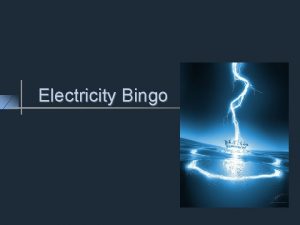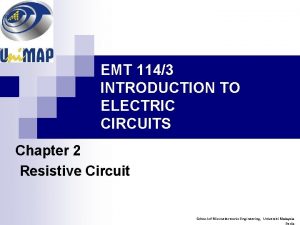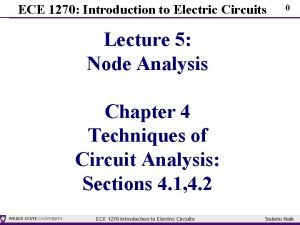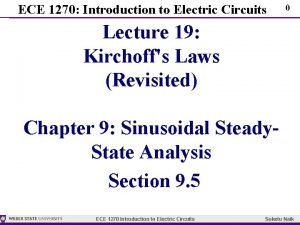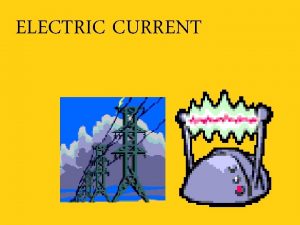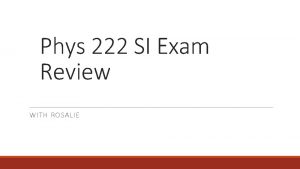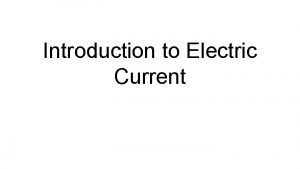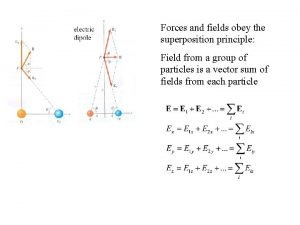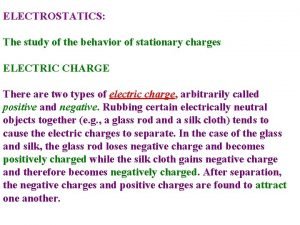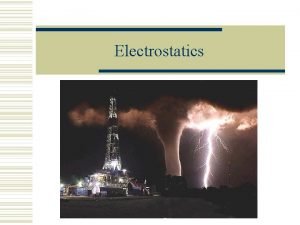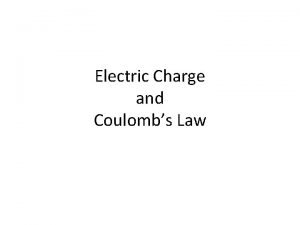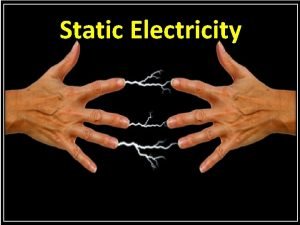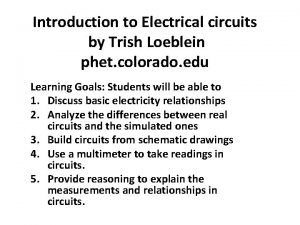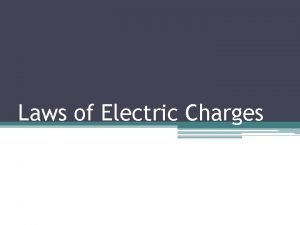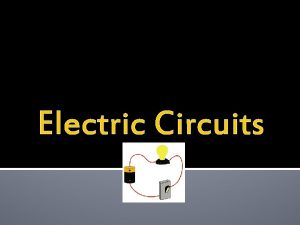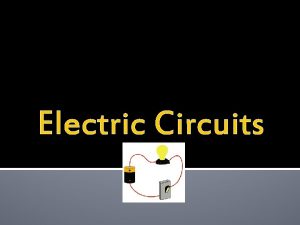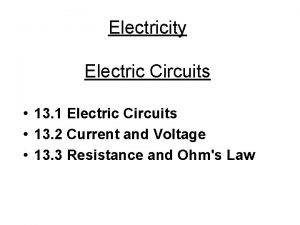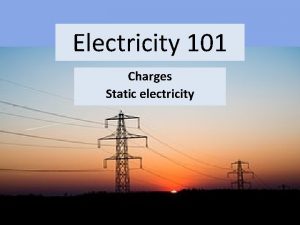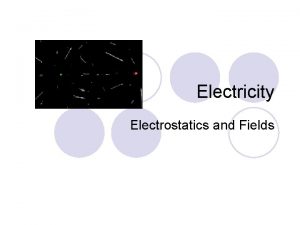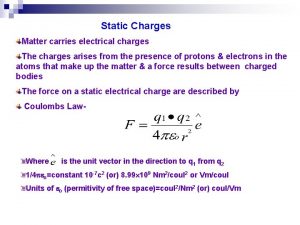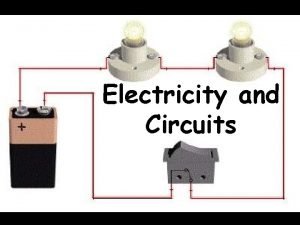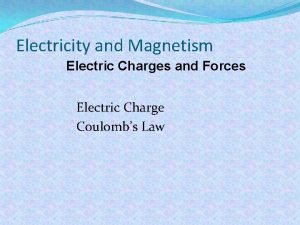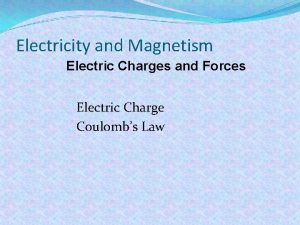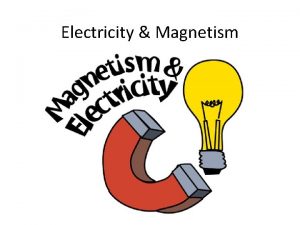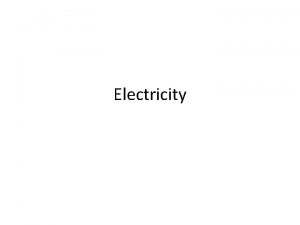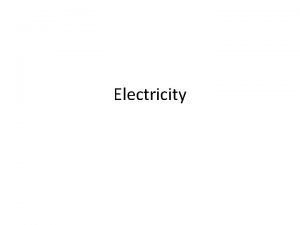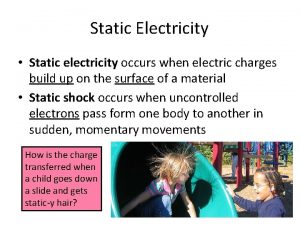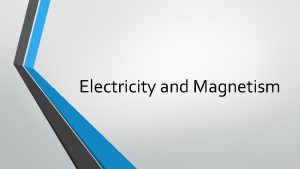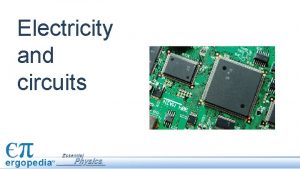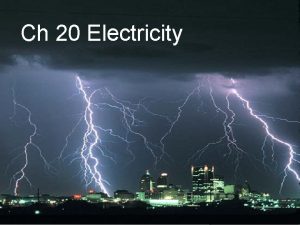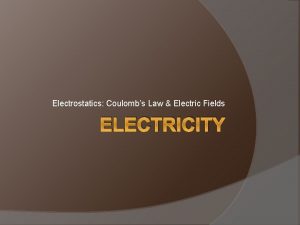Introduction to electricity and electric circuits electric charges























- Slides: 23

Introduction to electricity and electric circuits electric charges, currents and voltage

Example: He-Atom • 2 protons: + 2 e 2 neutrons: no charge 2 electrons: - 2 e • elementary charge, e = 1. 6 x 10 -19 C • Atoms are neutral, unless electrons are removed (or added) • Protons and neutrons consists of 3 quarks each.

Properties of Electric Charge • Charges are due to elementary particles: Protons carry (+ e), electrons carry (- e). • Charges are quantized: Q = n · e with n = ± 1, ± 2, ± 3, … and e = 1. 602 x 10 -19 C • Charges are conserved. • Charged objects exert a force onto each other: like charges repel each other, unlike charges attract each other.

Insulators versus conductors • Insulators (plastic, glass, air): All electrons are tightly bound or localized and cannot move. • No conduction electrons (or only very few): no transport of charge, i. e. electric currents.

Conductors (Metals) • Transport electric charges well. • There are freely moving conduction electrons and bound electrons that remain bound to the nucleus of each atom. • ions (nucleus + bound electrons) remain in place and form a crystal lattice (chemical bonds). • Electric current: Net motion of charges (free electrons in a metal). • Positive charges (ions) can only move in a liquid or a gas.

conduction electrons in a conductor

Electric current=Q/t

Conservation of current

Q 1. 1) 3 A in; 2) 2 A out; 3) 1 A in; 4) 4) 1 A out. ? Another example on Page 214, STT 8. 2

How to create an electric current What is the time-dependence of current in the wire?

A Battery needed to keep currents flowing !! Voltage of a battery

Electric potential Gravitational Potential Energy mgh Electrical potential Energy q. V Gravitational Potential gh Electrical potential V

The work done by the charge escalator or chemical forces W (chem) defines the voltage of a battery: W(chem) /q =terminal voltage of a battery

Some Typical Voltages Voltage Source Thundercloud to ground High-voltage power line Power supply for TV tube Automobile ignition Household outlet Automobile battery Flashlight battery Resting potential across nerve membrane Potential changes on skin (approx. ) 108 V 106 V 104 V 120 V 12 V 1. 5 V 10 -1 V 10 -4 V

Resistance/conductance • Valid for “ohmic” devices mainly metallic conductors at constant temperatures.

Ohm’s Law Current I = V / R, 1/R= σA V/d =G A is a cross section area of a wire, d is length. Conductivity σ. V is the voltage across the wire. *** Inverse of σ is called resistivity ρ, ρ = 1/σ R= ρ d/A

Resistivity of materials Material Copper Iron Seawater Blood Fat Muscle Pure water Resistivity 1. 7 X 10^{-8} 9. 7 X 10^{-8} 0. 22 1. 6 25 13 2. 5 X 10^5

Q 1 Two copper conductors, A and B, are of same lengths and are connected to two identical batteries. A has a bigger cross section than B. Which is the right I versus V graph?

Q 2 A and B conductors have same cross sections. But A is longer than B. Which is the correct graph?

Electrical Hazards Feel: 1 m. A pain: few m. A deadly: over 70 m. A Estimate the resistance of a human body !!

Grounded High Voltage Lines, 1 000 V Lightning Strikes 50 000 V Even if you are not directly hit by a lightning strike or a hot power line, there is danger: The potential decreases with distance from the location of the impact (potential gradient). If you take a step there may be a large potential difference between your feet. 0 V

Electrical Power • P = VQ/t = VI • Unit: Watt (W) = VA • k. W, MW, GW

Electrical power on the ohmic device • P = VI • V = RI (Ohm’s Law) • P = V 2/R = I 2 R
 Electric charges and electric forces lesson outline
Electric charges and electric forces lesson outline Like charges blank and opposite charges blank
Like charges blank and opposite charges blank Introduction to electric circuits
Introduction to electric circuits Find vx
Find vx Introduction to electric circuits
Introduction to electric circuits Static electricity and current electricity
Static electricity and current electricity Current electricity
Current electricity Electricity and magnetism vocabulary
Electricity and magnetism vocabulary Series parallel circuit current
Series parallel circuit current Electric circuits by james nilsson and susan riedel
Electric circuits by james nilsson and susan riedel Analogy between electric and magnetic circuits
Analogy between electric and magnetic circuits Net movement of electric charges in a single direction
Net movement of electric charges in a single direction The figure shows three electric charges labeled
The figure shows three electric charges labeled What is the continuous flow of electric charge?
What is the continuous flow of electric charge? Electric field due to system of charges
Electric field due to system of charges Study of stationary electric charges is
Study of stationary electric charges is Electron volt
Electron volt Same sign repel
Same sign repel Two 40 gram masses each with a charge
Two 40 gram masses each with a charge Coulombs unit
Coulombs unit Electricity flow
Electricity flow Phet electric circuit
Phet electric circuit Fundamentals of electric circuits chapter 4 solutions
Fundamentals of electric circuits chapter 4 solutions Electric current
Electric current

